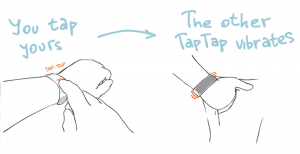 Christine Lemke posted a collection of links to wrist gadgets, which triggered a conversation between us on Twitter.
Christine Lemke posted a collection of links to wrist gadgets, which triggered a conversation between us on Twitter.
The list had your usual (yawn) suspects, such as FitBit, Jawbone, Basis, and Misfit. It also had the sports players such as Adidas, Reebok (also part of Adidas), Garmin, and Nike (all of these companies, I claim, have been in this wearable business longer than the current darlings in the previous sentence).
But two devices stuck out – Bond and TapTap.
Touch me
I am kinda tired of all these activity sensors that measure activity, sweat, location, acceleration, and so forth. Activity measurement is only scraping the surface. There are so many other ways sensors can enrich our awareness of our surroundings, ourselves, and our social networks.
When I was at Nokia, I was surrounded by these really smart interaction designers. We used to think of all the ways mobile and the internet could come together to enrich our lives (we use to ask “How does our second life [the digital life] enrich our first life [our physical, face-to-face life]).
Ambient and affective
One interesting area for us in those days was about tactile connection at a distance. Hence the two touch devices in Christine’s list are worth noting. They buck the pattern of traditional activity monitors. As Christine says, “Those [tactile connection devices] will likely be far more compelling applications to consumers.”
Christine brought up the Nabaztag, a curious bunny-looking device that could respond in some set ways (glow, move ears, make a noise) based on any digital input. Such “ambient computing” devices could be used to display activity inputs from another person. What happens now when wrist gadgets help us keep ambient awareness of other machines or people?
Achivemint, an activity tracking platform Christine co-founded, uses behavioural analysis to “nudge” folks to better activity choices, better health.
How might such affective wearables*, that tap into more than just activity, enhance Achivemint nudges? How do we go beyond the simple activity trackers to understand patterns of social connections, emotions, empathy? How does this action at a distance bring us closer to one another?
What’s the question?
Folks are chasing the activity sensors because they’re easy – cheap sensors, market awareness, simple algorithms. These gadgets are answering the question of “How active are you?”. And they’re trying to base all our analyses on that.
But the real question is when you step back and ask, “What can we do with sensors and connected devices that can enhance our lives?” To me, that’s the promise of wearable tech (and mobile devices, in general – which is where I’m coming from).
Let’s not get stuck inventing yet another activity tracking device. I want social connection trackers, emotional mappers (see Bond), psyche diviners, digital pheromones. Indeed, when we first started fusing the social web with mobiles, way back when, it was the emotional connection (dare I say, connecting people?) that drove us, not self quantifying.
C’mon, folks. We can do so much better.
Digital Pheromones
Her presence permeated the ordinary,
Lighting our pockets along the way.
We smile, and miss her.
With a sniff of sadness,
She knows we are here.
by: Phil, Riitta, Timo, and Charlie
Espoo – 31jan07
poem back story
*To quote the affective computing group at MIT: “Affective Computing is computing that relates to, arises from, or deliberately influences emotion or other affective phenomena.”
Image from TapTap, which did not make its Kickstart funding goal.